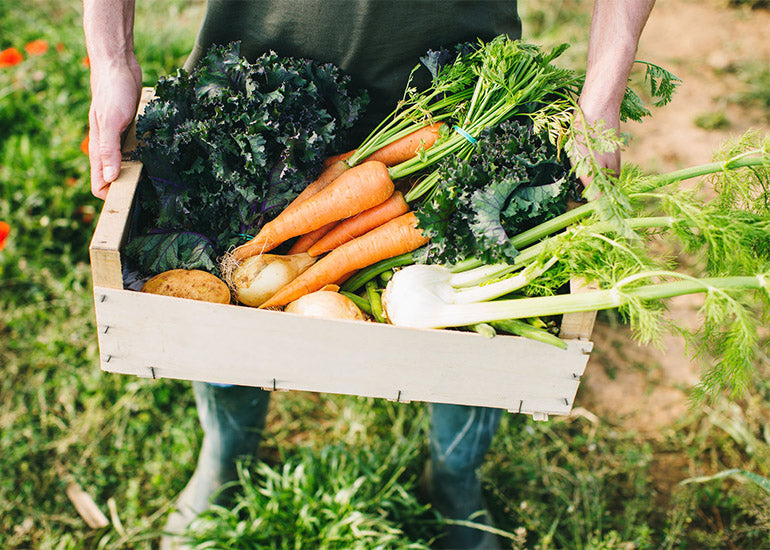The main deterrent to purchasing organic is often the price point, which many consumers can’t seem to justify. It makes sense; it can be tough to choose to spring more cash on organic fruits and veggies when their conventional counterparts seem exactly the same. While it can be easy to fall into this mentality, there are numerous (legit) reasons why organic foods often cost more. Curious? Read on for the top five reasons organic food is more expensive than conventional.
1. Organic Certification
It is expensive for a farm to become certified organic and to maintain that certification. In addition to initial application and site inspection fees, farms may also have to upgrade their equipment and are required to operate in an organic fashion for three years prior to achieving certification—without the income benefits that come with the USDA Certified logo. On top of these initial expenses, there are annual inspection and certification fees. All this adds up to about $875 up front plus $740-$1,500 for yearly renewal for a small farm or producer.¹
2. Operational Costs
To put it simply: it costs more to run an organic farm than a conventional one. From natural fertilizers to organic animal feed, the prices of materials used in organic farming far exceed the prices of synthetic, chemical and GMO materials used on conventional farms. In addition, organic farming relies more on traditional tilling, planting and harvesting methods—which means more labor. As organic farms are typically much smaller than conventional ones, they don’t benefit from economies of scale. All this factors into the cost of producing organic food.
3. Lower Yield
Organic farms produce smaller harvests—a.k.a. fewer sellable crops—than conventional farms. Many factors play into this: They typically have less land on which to grow. They don’t chemically alter the environment to kill pests and other threats. They don’t use GMOs. And they don’t rely on monocropping—crowding a plot with tons of the same crop. All of these practices, which are used by conventional farming, help produce an unnaturally high volume of crops. With less produce to sell, organic farms need to make the price point slightly higher.
4. Subsidies
Subsidies are payments given by the US government to certain farms and agribusinesses, which then lowers costs of that food for consumers (but keep in mind that the money comes from our taxes!). The government overwhelmingly subsidizes conventional agriculture over organic. Research conducted by the California Public Interest Research Group found that, “between 1995 and 2010, American taxpayers spent over $260 billion in agricultural subsidies, with most of these subsidies given to the largest farming operations in the United States. Worse, most subsidies were used to finance commodity crops such as corn and soybeans that are often processed into food additives like high fructose corn syrup and vegetable oil and then used in junk food.”² Good times.
5. Cleaner Ingredients
When an organic food product has a USDA organic certification, it means that at least 95% of its ingredients are certified organic—which are higher quality, more expensive ingredients. For instance, consider organic chia seeds, which are a staple in many health-conscious diets due to their numerous benefits. In addition, there is an extensive list of cheap, processed food additives, flavors and preservatives that are barred from inclusion in organic certified food products (because they may cause harm to our bodies)—but are used widely in conventional foods. Cheaper ingredients make conventional foods cheaper to produce, and thus cheaper to buy. In this case, the old adage is true: you get what you pay for.
Whether or not these reasons influence your decision to spend a little more of your hard-earned cash on organic foods is, of course, up to you. As a consumer, it’s important to equip yourself with knowledge to feel empowered and make informed decisions. Next time you’re in the produce aisle staring at that bunch of kale, you’ll at least know why it costs a tad more than the conventional kale across the way. Your move is up to you.
Curious to learn more about the differences between organic and conventional agriculture? Follow @navitasorganics on social media for more education on the importance of organic.
Sources:
¹COOF, “Organic Certification Fees”. Accessed Aug 13, 2019. <https://www.ccof.org/certification/how/organic-certification-fees>.
²The Balance Small Business, “10 Reasons Organic Food Costs More”. Accessed Aug 13, 2019. <https://www.thebalancesmb.com/reasons-organic-food-costs-more-2538165>.
AUTHOR BIO
Meredith is Navitas Organics’ Product Marketing Manager. The first Navitas product she ever purchased was Cacao Powder, with which she is still obsessed. A student of mindfulness and passionate advocate of mental health, Meredith leads meditation for Navitas Organics team members. She loves cooking and sharing information about the healing powers of real food!
)
